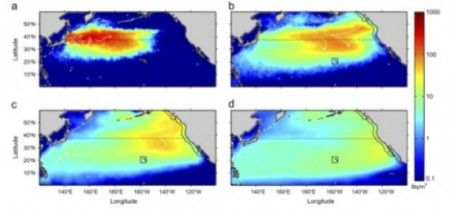A German study modelling the effects of an uncontained core meltdown suggests the Pacific Ocean is imperiled. The “German Risk Study, Phase B” found that a core meltdown accident could result in complete failures of all structural containment, causing melted fuel to exit the reactor foundation within five days (cited in Bayer, Tromm, & Al-Omari 1989). Moreover, the study found that even in the event of an intact building foundation, passing groundwater would be in direct contact with fuel, causing leaching of fission products. Strontium leaches slower than cesium. A follow-up German study, “Dispersion of Radionuclides and Radiation Exposure after Leaching by Groundwater of a Solidified Core-Concrete Melt,” predicted that strontium contamination levels would rise exponentially years after a full melt-through located adjacent to a river (Bayer, Tromm, & Al-Omari, 1989).
The study predicted concentrations of Strontium-90 in river water would spike relatively suddenly, but maintain extraordinarily high levels of contamination for years. Strontium bio-accumulates in the human body, including the brain, and is a known genotoxin. The study’s experimental conditions are roughly similar to Daiichi’s site conditions and strontium levels have been spiking there since the summer of 2013. TEPCO just reported that strontium levels in reactor basement water ranged from 40 million to 500 million becquerels per liter (“TEPCO to Improve,” 2014).
(Read the rest of the story here…)
